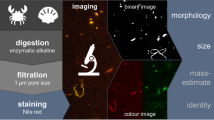Abstract
The dithizone extraction method has been applied in the determination of lead content in human bones. The lead in 21 samples of fresh vertebrae and ribs from autopsies is compared with the lead content of historical bones of 17 skeletons from 600–800 A.D.
The preparation and the direct mineralization of the bones are presented. The lead content detected in the ash of bones is to low compared with the value found by direct wet mineralization of the bones. During the dry ashing process with temperatures of 500° C or higher lead may be lost.
For the same person the lead content of rib is always lower than the value found in vertebra. The difference of the lead content of fresh bones and the historical bones is only small. In both groups the lead content in the bones increased with age.
Compared with studies of other authors in the time of 1930–1970 the results would suggest that the present intake of lead in accidental selected bones among a population situated in an appointed area is not greater than in the past.
Zusammenfassung
Durch Extraktion mit Dithizon wurde der Bleigehalt menschlicher Knochen bestimmt. Von 21 Autopsien wurde der Bleigehalt der frischen Wirbel und Rippen mit demjenigen historischer Knochen von 17 Skeletten aus dem 6./8. Jahrhundert n. Chr. verglichen.
Die Präparierung und die direkte Mineralisation der Knochen werden beschrieben. Der in der Knochenasche bestimmte Bleigehalt ist niedriger als der, welcher bei direkter nasser Mineralisation der Knochen gefunden wird. Während der trockenen Veraschung, bei welcher Temperaturen von 500° C oder höher angewendet werden, kann Blei verlorengehen.
Für dieselbe Person ist der Bleigehalt der Rippe immer niedriger als der im Wirbel gefundene Wert. Der Unterschied im Bleigehalt von frischen Knochen und historischen Knochen ist nur gering. In beiden Gruppen nimmt der Bleigehalt in den Knochen mit steigendem Alter zu.
Verglichen mit den in den Jahren von 1930–1970 durchgeführten Untersuchungen anderer Autoren zeigen unsere Resultate, daß die gegenwärtige Aufnahme von Blei in zufälligen Stichproben einer regionalen Bevölkerung nicht größer ist als zu früheren Zeiten.
Similar content being viewed by others
Literatur
Bagchi, K. N., Ganguly, H. D., Sirdar, J. N.: Lead in human tissues. Indian med. Res. Mem. 26, 935 (1939)
Barry, P. S. I., Mossmann, D. B.: Lead concentrations in human tissues. Brit. J. industr. Med. 27, 339 (1970)
Barry, P. S. I.: A comparison of concentrations of lead in human tissues. Brit. J. industr. Med. 32, 119 (1975)
Cherry, W. H., Esterby, S. R., Finch, A., Forbes, W. F.: Studies of trace metal levels in human tissues. 2. The investigation of lead levels in rib samples of 100 canadian residents. Trace Subst. Environ. Health 9, 29 (1975)
Forbes, W. F., Finch, A., Esterby, S. R., Cherry, W. H.: Studies of trace metal lead levels in human, tissues. 3. The investigation of lead levels in rib and vertebra samples from Canadian residents. Trace Subst. Environ. Health 10, 41 (1976)
Grandjean, P., Holma, B.: A history of lead retention in the danish population. Environ. Physiol. Biochem. 3, 268 (1973)
Gross, S. B., Pfitzer, E. A., Yeager, D. W., Kehoe, R. A.: Lead in human tissues. Toxicol. appl. Pharmacol. 32, 638 (1975)
Hammond, P. B.: Essays in toxicology. (F. R. Blood, ed.) Vol. 1. New York: Academic Press 1969
Hansmann, G. H., Perry, M. C.: Lead absorption and intoxication in man unassociated with occupations or industrial hazards. Arch. Path. 30, 226 (1940)
Henderson, D. A., Inglis, J. A.: The lead content of bone in chronic Bright's diseases. Aust. Ann. Med. 6, 145 (1957)
Khera, A. K., Wibberley, D. G.: Some analytical problems concerning trace-metal analysis in human placentas. Proc. Anal. Div. Chem. Soc. 13 (11), 340 (1976)
Maruna, R. F. L., Stipinovic, G.: Über den Bleigehalt der Oberschenkel von Unfallpatienten im Raum Wien. Wien. med. Wschr. 124, 616 (1974)
Maulbetsch, A., Rutishauser, E.: La teneur des dents en plomb. Arch. int. Pharmacodyn. 53, 55 (1936)
Nemeskéri, J., Harsányi, L., Acsádi, Gy.: Methoden zur Diagnose des Lebensalters von Skelettfunden. Anthrop. Anz. 24, 70 (1960)
Nusbaum, R. E., Butt, E. M., Gilmour, T. C., Didio, S. L.: Relation of air pollutants to trace metals in bone. Arch. environm. Hlth 10, 227 (1965)
Schroeder, H. A., Tipton, I. H.: The human body burden of lead. Arch. environm. Hlth 17, 965 (1968)
Strehlow, C. D., Kneip, T. J.: The distribution of lead and zinc in the human skeleton. Amer. industr. Hyg. Ass. J. 30, 372 (1969)
Teisinger, J., Prerovska, I., Sedivec, V., Flek, J., Roth, Z.: Attempt on determination of biologically active lead in organism in experimental poisoning. Arch. Gewerbepath. Gewerbehyg. 25, 240 (1969)
Tompsett, S. L.: The distribution of lead in human bones. Biochem. J. 30, 345 (1936)
Tompsett, S. L.: Determination and distribution of lead in human tissues and excreta. Analyst 81, 330 (1956)
Tompsett, S. L., Anderson, A. B.: The lead content of human tissues and excreta. Biochem. J. 29, 1851 (1935)
Weinig, E., Börner, B.: Über den normalen Bleigehalt der menschlichen Knochen. Arch. Toxikol. 19, 34 (1961)
Weyrauch, F., Müller, H.: Über den Bleigehalt in Organen und Knochen bei bleikranken und bleigefährdeten Menschen. Arch. Hyg. (Berl.) 114, 46 (1935)
Author information
Authors and Affiliations
Additional information
Herrn Prof. Dr. med. G. Dotzauer zum 65. Geburtstag gewidmet
Wir danken dem Archäologischen Dienst des Kantons Bern für die Überlassung des Knochenmaterials, Susi Ulrich-Bochsler für die Alters- und Geschlechtsdiagnosen der historischen Skelette sowie Rolf Viehweg und Beat Rettenmund für die sorgfältige Ausarbeitung und Durchführung der Bleianalysen.
Rights and permissions
About this article
Cite this article
Ulrich, L. Untersuchungen über den Bleigehalt in Wirbeln und Rippen. Arch. Toxicol. 41, 133–148 (1978). https://doi.org/10.1007/BF00302525
Received:
Issue Date:
DOI: https://doi.org/10.1007/BF00302525




